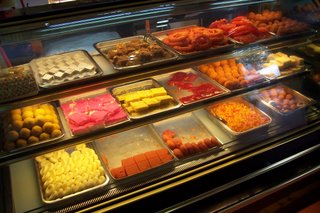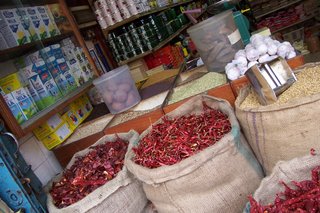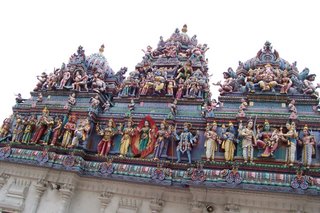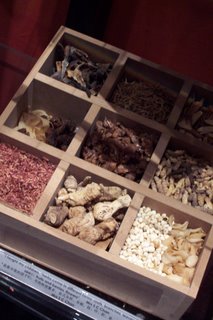This tour brings participants along what is commonly referred to as Little India in Singapore. The tour guide greeted us "Welcome" in Tamil, and she was wearing a North Indian punjabi suit. Were these to complement the theme of the tour?
The tour started with an introduction that bought us to hear about how Race Course Road was like in the good old days. There was more, but I shall leave it to you to join this tour to find all these out for yourself.
The next part of the tour brought us to the Tekka Wet Market. What does Tekka mean? Where was the original location of the Tekka Wet Market? What are the characteristics of a wet market? The answers to these questions will be revealed on the tour, of course.
Till you join the tour, I could only bear to tempt you with scenes from the wet market.

The floor of the market is wet. Wear good shoes on this tour. In my opinion, doing so would help prevent one from slipping.
My favourite section of the market is that of the fruits. Whichever market that I am in, the fruits section never fails to bring me the fragrant smell that only fruits could bring.

Along our walk about the wet market, the guide pointed us to various interesting items that were sold in the market. For example, the "drumstick", believed by the Indians to have aphrodisiac properties. Also, we get to hear about the tonic black chicken that you would see below.

More interesting thing awaits. This part of the tour will definitely lend the novice some insights to parrot-astrology.

This tour unravels many interesting stories about the past of Little India. Many buffaloes used to roam about in Little India. Is it a pity that we have progressed so much that people from my generation could no longer witness the rearing of buffaloes on that very same grounds?
Anyway, the tour has given me more insights to the history of this little island that I inhabit in. It also gave me more insight to the culture of the Indians in Singapore.

One of the stops for the tour was the Little Indian Arcade. Here, I learnt more about the art of Henna Tattooing, Indian candies and even got to see a demonstration of how the Indian saris is being worn. The guide also shared with us about the pottu and the symbolic meanings behind it.


Little India is charming in its own way. Occasionally, as one walked along the streets of Little India, one may find himself welcomed by the exotic smell from the Indian spices. Some of the shop houses in the area have been existing way before yours truly was born.



I think I will never look at decorative items found on the doorway as simply decorative items. Look at the dried mango leaves on the doorway that you would see below. If you were to see mango leaves like these hanging on the doorway, there is high likelihood that that place of residence belongs to an Indian household. If you want to know why this is so, please ask the tour guide.


One of our final stops was the Sri Veeramakaliamman Temple. Here, I learnt a little more about the Hindu religion. Thanks to the guide.





Finally, the tour was concluded at an open space nearby the Sri Veeramakaliamman Temple. Certainly, this tour has been an educational one, even for a local Singapore citizen like myself.
As I part from the rest of the group, my eyes were attracted to the colourful garland from a shop nearby.

I couldn't agree more that Little India is full of life, colours and more. And if you are still deliberating whether to go for this walking tour or not, do consider the former option too.
Information on this tour can be found here: http://www.journeys.com.sg/singaporewalks/tours_dhobis.asp
























